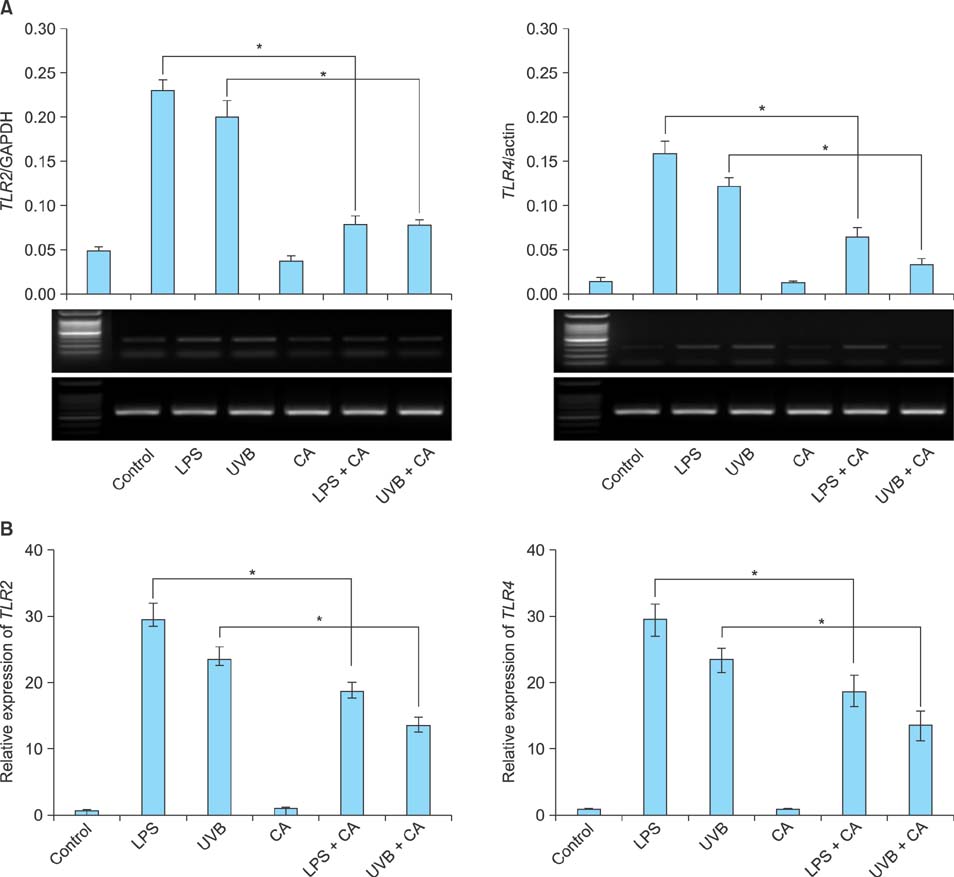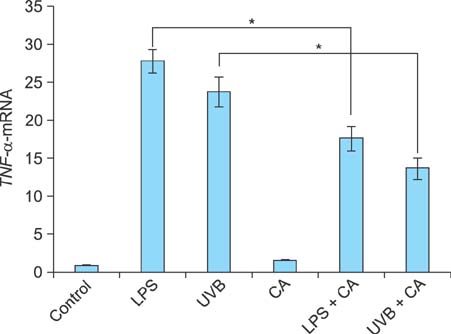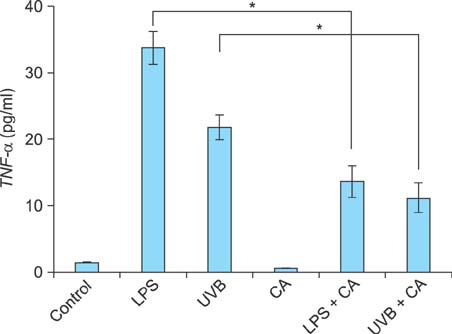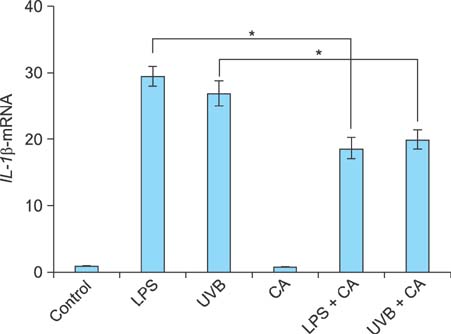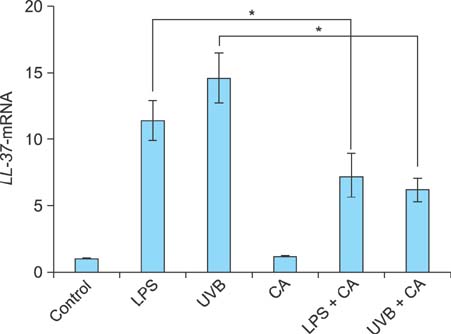Ann Dermatol.
2014 Jun;26(3):296-302.
Calcitriol May Down-Regulate mRNA Over-Expression of Toll-Like Receptor-2 and -4, LL-37 and Proinflammatory Cytokines in Cultured Human Keratinocytes
- Affiliations
-
- 1Department of Dermatology, Chung-Ang University Hospital, Seoul, Korea. drseo@cau.ac.kr
Abstract
- BACKGROUND
Although vitamin D analogs have been used in the topical treatment of psoriasis, their mechanisms of action are not well understand. Calcitriol, the hormonally active vitamin D3 metabolite, has been demonstrated to exert immunomodulatory effects in the skin by down-regulating the expression of Toll-like receptors (TLRs) and proinflammatory cytokines.
OBJECTIVE
We investigated the effects of calcitriol on the expression of TLR2, TLR4, antimicrobial peptide LL-37, and proinflammatory cytokines in cultured human keratinocytes.
METHODS
The mRNA expression levels of TLR2, TLR4, tumor necrosis factor alpha (TNF-alpha), interleukin (IL)-1beta and LL-37 in cultured human keratinocytes were measured by real-time polymerase chain reaction (PCR) and reverse transcription (RT). Furthermore, we measured supernatant TNF-alpha levels by an enzyme-linked immunosorbent assay (ELISA) to confirm the effects of calcitriol on TLR2 and TLR4.
RESULTS
As measured by RT-PCR and real-time PCR, calcitriol was found to suppress the lipopolysaccharide- and ultraviolet B radiation-mediated induction of expression of TLRs, LL-37 and proinflammatory cytokines such as TNF-alpha and IL-1beta in normal human keratinocytes. The supernatant TNF-alpha levels measured by ELISA were also suppressed after treatment with calcitriol.
CONCLUSION
Calcitriol may down-regulate inflammatory stated over-expression of LL-37 and proinflammatory cytokines.
Keyword
MeSH Terms
-
Calcitriol*
Cholecalciferol
Cytokines*
Enzyme-Linked Immunosorbent Assay
Humans
Interleukins
Keratinocytes*
Psoriasis
Real-Time Polymerase Chain Reaction
Reverse Transcription
RNA, Messenger*
Skin
Toll-Like Receptors
Tumor Necrosis Factor-alpha
Vitamin D
Calcitriol
Cholecalciferol
Cytokines
Interleukins
RNA, Messenger
Toll-Like Receptors
Tumor Necrosis Factor-alpha
Vitamin D
Figure
Reference
-
1. Weber G, Heilborn JD, Chamorro Jimenez CI, Hammarsjo A, Törmö H, Stahle M. Vitamin D induces the antimicrobial protein hCAP18 in human skin. J Invest Dermatol. 2005; 124:1080–1082.
Article2. Zasloff M. Sunlight, vitamin D, and the innate immune defenses of the human skin. J Invest Dermatol. 2005; 125:xvi–xvii.
Article3. Wang TT, Nestel FP, Bourdeau V, Nagai Y, Wang Q, Liao J, et al. Cutting edge: 1,25-dihydroxyvitamin D3 is a direct inducer of antimicrobial peptide gene expression. J Immunol. 2004; 173:2909–2912.
Article4. Schauber J, Dorschner RA, Coda AB, Büchau AS, Liu PT, Kiken D, et al. Injury enhances TLR2 function and antimicrobial peptide expression through a vitamin D-dependent mechanism. J Clin Invest. 2007; 117:803–811.
Article5. Liu PT, Stenger S, Li H, Wenzel L, Tan BH, Krutzik SR, et al. Toll-like receptor triggering of a vitamin D-mediated human antimicrobial response. Science. 2006; 311:1770–1773.
Article6. Sadeghi K, Wessner B, Laggner U, Ploder M, Tamandl D, Friedl J, et al. Vitamin D3 down-regulates monocyte TLR expression and triggers hyporesponsiveness to pathogen-associated molecular patterns. Eur J Immunol. 2006; 36:361–370.
Article7. Do JE, Kwon SY, Park S, Lee ES. Effects of vitamin D on expression of Toll-like receptors of monocytes from patients with Behcet's disease. Rheumatology (Oxford). 2008; 47:840–848.
Article8. Kim BJ, Rho YK, Lee HI, Jeong MS, Li K, Seo SJ, et al. The effect of calcipotriol on the expression of human beta defensin-2 and LL-37 in cultured human keratinocytes. Clin Dev Immunol. 2009; 2009:645898.9. Khoo AL, Chai LY, Koenen HJ, Oosting M, Steinmeyer A, Zuegel U, et al. Vitamin D(3) down-regulates proinflammatory cytokine response to Mycobacterium tuberculosis through pattern recognition receptors while inducing protective cathelicidin production. Cytokine. 2011; 55:294–300.
Article10. Ohashi K, Burkart V, Flohé S, Kolb H. Cutting edge: heat shock protein 60 is a putative endogenous ligand of the toll-like receptor-4 complex. J Immunol. 2000; 164:558–561.
Article11. Cohen-Sfady M, Nussbaum G, Pevsner-Fischer M, Mor F, Carmi P, Zanin-Zhorov A, et al. Heat shock protein 60 activates B cells via the TLR4-MyD88 pathway. J Immunol. 2005; 175:3594–3602.
Article12. Wadia P, Atre N, Pradhan T, Mistry R, Chiplunkar S. Heat shock protein induced TCR gammadelta gene rearrangements in patients with oral cancer. Oral Oncol. 2005; 41:175–182.
Article13. Kumar A, Zhang J, Yu FS. Toll-like receptor 2-mediated expression of beta-defensin-2 in human corneal epithelial cells. Microbes Infect. 2006; 8:380–389.
Article14. Peric M, Koglin S, Kim SM, Morizane S, Besch R, Prinz JC, et al. IL-17A enhances vitamin D3-induced expression of cathelicidin antimicrobial peptide in human keratinocytes. J Immunol. 2008; 181:8504–8512.
Article15. Peric M, Koglin S, Dombrowski Y, Gross K, Bradac E, Büchau A, et al. Vitamin D analogs differentially control antimicrobial peptide/"alarmin" expression in psoriasis. PLoS One. 2009; 4:e6340.16. Lande R, Gregorio J, Facchinetti V, Chatterjee B, Wang YH, Homey B, et al. Plasmacytoid dendritic cells sense self-DNA coupled with antimicrobial peptide. Nature. 2007; 449:564–569.
Article17. Gambichler T, Skrygan M, Tomi NS, Othlinghaus N, Brockmeyer NH, Altmeyer P, et al. Differential mRNA expression of antimicrobial peptides and proteins in atopic dermatitis as compared to psoriasis vulgaris and healthy skin. Int Arch Allergy Immunol. 2008; 147:17–24.
Article18. Chamorro CI, Weber G, Grönberg A, Pivarcsi A, Ståhle M. The human antimicrobial peptide LL-37 suppresses apoptosis in keratinocytes. J Invest Dermatol. 2009; 129:937–944.
Article
- Full Text Links
- Actions
-
Cited
- CITED
-
- Close
- Share
- Similar articles
-
- Expression of Toll-like Receptor 2 in Cultured Human Keratinocytes: The Effect of Bacterial Antigens, Cytokines and Calcium Concentration
- Nucleic Acid Recognition and Signaling by Toll-like Receptor 9: Compartment-dependent Regulation
- Expression of Toll-Like Receptors in Verruca and Molluscum Contagiosum
- Epidermal Growth Factor Attenuated the Expression of Inflammatory Cytokines in Human Epidermal Keratinocyte Exposed to Propionibacterium acnes
- Hyaluronan Oligosaccharides Improve Rosacea-Like Phenotype through Anti-Inflammatory and Epidermal Barrier-Improving Effects

